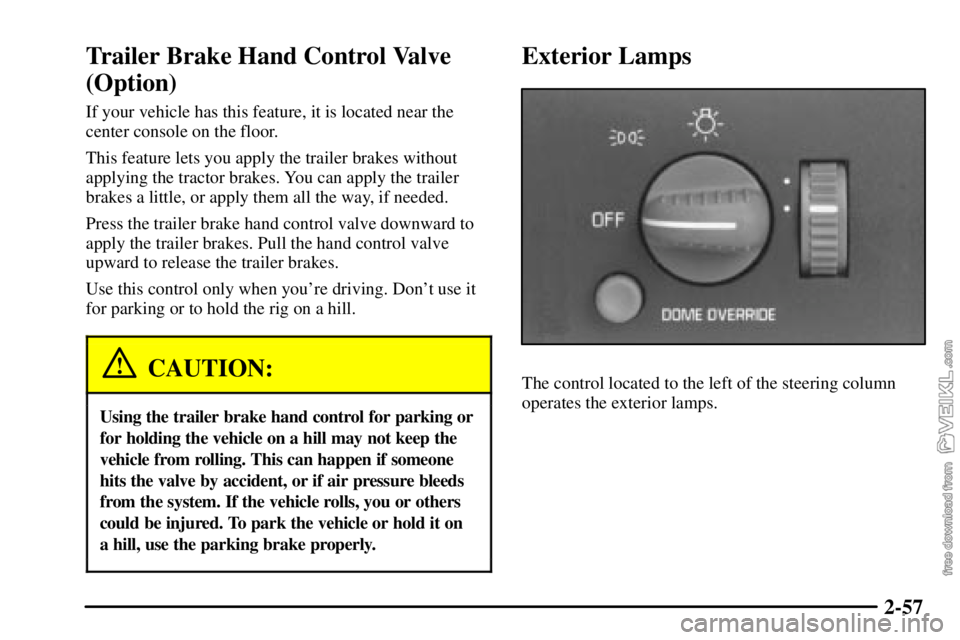Page 13 of 386
1-6
Chugger-Snubber Lock-Out Feature (If Equipped)
If your vehicle has this
feature, the handle is
located on the outboard
sides of the driver's and
passenger's seats.
Move the handle down to minimize any backslap
experienced while in tractor/trailer operation or while
operating a dump truck application. This feature is only
available on low
-back seats.
Reclining Front Seatbacks (If Equipped)
If your vehicle is equipped with bucket seats, you can
recline the seatbacks. The lever is located on the
outboard side of the seat cushion.
To recline the seatback, lift the lever and use your body
to move the seatback. Release the lever to lock the
seatback where you want it. Lean forward and pull up
on the lever to return the seatback to an upright position.
Page 76 of 386

2-
2-1
Section 2 Features and Controls
Here you can learn about the many standard and optional features on your vehicle, and information on starting,
shifting and braking. Also explained are the instrument panel and the warning systems that tell you if everything is
working properly
-- and what to do if you have a problem.
2
-2 Windows
2-5 Keys
2-7 Door Locks
2-8 Keyless Entry System (If Equipped)
2-12 Switchbanks
2-13 Theft
2-14 New Vehicle ªBreak-Inº
2-15 Ignition Positions
2-16 Starting Your Gasoline Engine
2-19 Starting the Diesel Engine
2-24 Starting Your DURAMAX� Diesel Engine
2-27 Engine Checks Before Operating
2-28 Engine Coolant Heater (If Equipped)
2-30 Diesel Engine Exhaust Brake (If Equipped)
2-31 Two-Speed Rear Axle Electric Shift Control
(If Equipped)
2
-34 Automatic Transmission Operation
2-36 Manual Transmission Operation
2-40 Parking
2-45 Parking Over Things That Burn
2-45 Engine Exhaust2
-46 Running Your Engine While You're Parked
(Automatic Transmission)
2
-47 Horn
2-48 Tilt Wheel (If Equipped)
2-48 Turn Signal/Multifunction Lever
2-55 Inter-Axle Differential Lock Control
(If Equipped)
2
-56 Rear Axle Differential Lock Control
(If Equipped)
2
-57 Exterior Lamps
2-60 Interior Lamps
2-61 Mirrors
2-63 Storage Compartments
2-65 Accessory Power Outlets
2-66 Trailer Connections (C4/C5 Models Only)
(If Equipped)
2
-67 Trailer Connections (C6/C7/C8 Models Only)
(If Equipped)
2
-68 The Instrument Panel-Your
Information System
2
-70 Instrument Panel Cluster
2-73 Warning Lights, Gages and Indicators
Page 111 of 386

2-36 Overdrive Defeat (If Equipped)
If your vehicle has this feature, you can select not to
shift up to fifth gear. This is useful when towing or
under a heavy load.
The overdrive defeat switch
is located in the instrument
panel to the right of the
steering column.
Press the switch to limit the transmission to fourth gear.
This will allow for better fuel economy and fewer
downshifts while pulling a tractor or trailer or under a
heavy load. The indicator light in the switch will come
on whenever overdrive defeat is active.
Manual Transmission Operation
Using the Clutch
When you're starting to move the vehicle, it's important
to begin with the engine speed at idle. Then start to
engage the clutch and listen for an engine speed drop
of about 100 rpm. At this point, the clutch is engaging,
so you should increase the engine speed and fully
engage the clutch. It's important not to increase the
engine speed sooner or before the clutch begins it's
engagement. If you do, you can cause damage to
your vehicle.
Double-Clutching
You must use the double-clutching method when you
shift an unsynchronized gear set. Disengage the clutch,
shift to neutral and engage the clutch. When upshifting,
slow the engine until the engine rpm and road speed
match. When downshifting, accelerate the engine until
the engine rpm and road speed match. Then quickly
disengage the clutch and move the shift lever to the next
gear position and engage the clutch.
Page 112 of 386

2-37 Eaton Fuller Five and Six-Speed
Transmissions and TTC Spicer
Seven-Speed Transmissions
These transmissions have gears that automatically
synchronize when you shift up or down (except
FIRST (1) gear on the five
-speed and seven-speed
transmission which is unsynchronized). Choose the gear
that will maintain the road speed you want while
keeping the engine above two
-thirds of the governed
speed. When the engine speed drops below two
-thirds of
the governed speed, shift into the next lower gear before
your engine begins to lug. When you shift down, be sure
to double
-clutch if required.
ZF Six-Speed Transmission
Here's how to operate
your transmission.
This six
-speed pattern is unique to GM manual
transmissions. The transmission always repositions
the shift lever to neutral, which is located between
FOURTH (4) and FIFTH (5) gear.
To prevent unintentional gear selections, additional
force is required to move the shift lever into
REVERSE (R) or FIRST (1). Use FIRST (1) when
trailer towing, driving with payload in the pickup box or
launching on a grade. Otherwise, start in SECOND (2)
gear. Only shift into FIRST (1) when the vehicle has
stopped moving.
Page 117 of 386
2-42 Air Brake (If Equipped)
CAUTION:
When the yellow SYSTEM PARK and the red
TRAILER AIR SUPPLY knobs are both pushed
in, your rig will be free to move. It could strike
someone or something. When both of these knobs
are pushed in, hold the regular brake pedal down
to keep your rig from moving.
If your vehicle has air
brakes, you will have this
parking brake. It is located
above the radio in the
instrument panel.
Pulling it out applies the parking brake. The park brake
light will come on when the air parking brake is applied.
Page 118 of 386
2-43
Vehicles built for use as tractors or towing vehicles have
two air brake controls. They look like this:To charge a trailer's air brake system do the following:
1. Move your tractor into the proper position.
2. Apply the parking brake by pulling the yellow
parking brake knob out.
3. Hook up the trailer air system properly.
4. Get into the tractor.
5. Push and hold down the regular brake pedal.
6. Push in both the yellow parking brake and the red
trailer air supply knobs. This will charge your
trailer's air system.
After a few minutes, the trailer system should be fully
charged. When it is, the air pressure gage will show
about 125 to 135 psi (862 to 931 kPa).
For driving with a trailer, the yellow and red
(if equipped) knobs must be pushed in. It's the same
when you're not pulling a trailer except that the red
trailer air supply knob must be pulled out.
Page 119 of 386

2-44
CAUTION:
If you apply any one of the air brake parking
controls while the vehicle is moving, your rig will
stop suddenly. If you are not ready for this, you
or others could be injured. Don't apply any one
of these controls while you're driving, unless you
have to make an emergency stop.
If the air pressure drops below 60 to 70 psi (413 to
482 kPa), the primary brake light and warning buzzer
will come on. If the air pressure drops to 35 to 45 psi
(241 to 310 kPa), the red trailer air supply knob will
automatically pop out and apply the spring brakes on
the trailer.If the air pressure drops to 35 to 45 psi (241 to 310 kPa),
the yellow park brake knob will automatically pop out
and apply the spring brakes on the truck or tractor.
If you ever have a complete loss of air so that your air
brakes automatically apply, there is a way that the tow
operator can release the parking brakes to tow the
vehicle. See ªTowing Your Vehicleº in the Index.
CAUTION:
If your vehicle is left in gear, the engine can start
if the vehicle starts to roll. This can easily happen
if you have the diesel engine. Shift the
transmission into NEUTRAL (N) before you
leave the vehicle.
Page 132 of 386

2-57
Trailer Brake Hand Control Valve
(Option)
If your vehicle has this feature, it is located near the
center console on the floor.
This feature lets you apply the trailer brakes without
applying the tractor brakes. You can apply the trailer
brakes a little, or apply them all the way, if needed.
Press the trailer brake hand control valve downward to
apply the trailer brakes. Pull the hand control valve
upward to release the trailer brakes.
Use this control only when you're driving. Don't use it
for parking or to hold the rig on a hill.
CAUTION:
Using the trailer brake hand control for parking or
for holding the vehicle on a hill may not keep the
vehicle from rolling. This can happen if someone
hits the valve by accident, or if air pressure bleeds
from the system. If the vehicle rolls, you or others
could be injured. To park the vehicle or hold it on
a hill, use the parking brake properly.
Exterior Lamps
The control located to the left of the steering column
operates the exterior lamps.